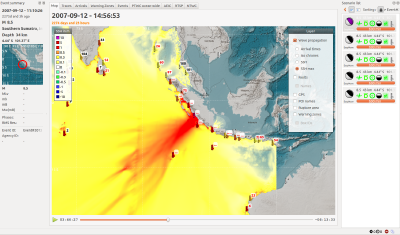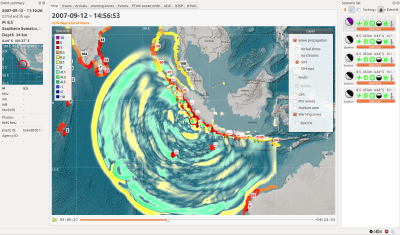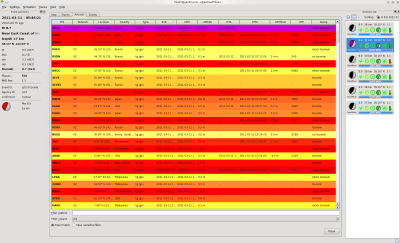TOAST
Tsunami observation and simulation
Overview

TOAST at a glance
- Tsunami simulation and comparison with observations
- Direct connectivity to SeisComP
- Automatic reception of earthquake information
- On-the-fly simulation with optional GPU calculation
- Calculation of SSH, SSHMax, isochrones, arrival times, coastal wave heights
- Automatic and interactive generation of rupture area
- Aggregation of scenarios to determine overall worst case
- Configuration of Points of Interests (POI)s with different types of sensors (tide gauge, buoy, etc)
- Generation of bulletins based on predefined templates
- Video output and playback of simulations
- Integration of oceanographic sensor data
- Automatic tsunami onset detection
Introduction

TOAST (Tsunami Observation And Simulation Terminal) is a software for tsunami simulation and verification giving a quick hazard assessment. The results can be verified by oceanographic sensors such as tide gauges or buoys. TOAST is developed by gempa GmbH, a spin-off from GFZ Potsdam (developer of the real-time earthquake processing and analysis system SeisComP). gempa is the SeisComP service and development company and has contributed to key components of the German Indonesian Tsunami Early Warning System (GITEWS).
During the development of the GITEWS software used by BMKG in Jakarta it soon became apparent that the system was complex and specialized to an extent which made it hard to offer to other institutes. Therefore gempa started the development of TOAST, a very flexible tsunami early warning software with high scalability.
TOAST is perfectly complementing SeisComP for the implementation of a fully functional tsunami warning system. TOAST is fully optimized for its application: Tsunami Early Warning. While conventional tsunami early warning systems are based on huge databases of pre-calculated scenarios. By default TOAST uses an on-the-fly simulation approach. Because of this approach TOAST can react to any atypical events, for example earthquakes in unconsidered areas or earthquakes with atypical rupture mechanisms. Additional to this on-the-fly simulation, TOAST’s flexible simulation interface also allows integration of existing pre-calculated scenario databases.
Workflow

TOAST connects to a SeisComP system and listens to the incoming earthquake parameters. In case a hypocenter and magnitude arrives, TOAST uses a Wells & Coppersmith (1984) formula to generate the rupture size based on magnitude. By default the rupture area is centered around the epicenter, and the strike and dip information is derived from pre-configured fault information. Once the rupture area is generated, the simulation plugins are triggered.
EasyWave
By default EasyWave is used for on-the-fly tsunami simulation. In addition, plugins exist for reading different pre-calculated tsunami databases. Such databases are generated by external software such as TsunAWI.
The earthquake rupture area can be placed at multiple pre-configured positions relative to the hypocenter and simulations for several positions can be calculated on the fly in parallel. As the earthquake information change over time, new simulations are triggered automatically with each relevant update. The rupture areas can also be generated manually and simulations using these can be started.
Easy-to use operator interface
TOAST provides different perspectives showing the results of the simulation. They comprise the following features:
- Time dependent simulated Sea Surface Height
- Simulated maximum Sea Surface Height
- Simulated isochrones
- Simulated tsunami travel times
- Estimated tsunami arrivals
- Estimated tsunami coastal wave height
- Observed tsunami arrivals through manual onset picking
- Observed tsunami Wave Heights and Periods through manual picking
- Points of interest and oceanographic sensors
- Fault information
- Rupture area
- Earthquake parameters
- Simulation progress
- Simulation quality
- Bulletin
To verify the simulation results, TOAST provides a manual tsunami onset picker. It allows to pick tsunami onsets, amplitudes and periods based on real-time tide gauge observations. The observed information is then used to calculate a scenario quality which represents how well the simulated and observed values match.
For example the quality of the oceanographic sensors is indicated by the color of the tide gauge symbol in the simulation widget. The simulation widget shows these quality parameter not only for the tide gauge data, but also for epicenter location, depth, magnitude, comparison with pre-configured rupture mechanisms and existing moment tensors. The quality information can change with time as TOAST compares the simulation information with the updated earthquake and tsunami information.
TOAST in media
TOAST is in use world-wide. Videos and images generated by TOAST are not only used at data centers but also broadcasted to the public by news channels. Watch how tsunami simulations by TOAST have impacted the tsunami alerts made available after the M7.5 earthquake in the Flores Sea, Indonesia, on 14 December, 2021.
Multiuser version
TOAST has undergone a significant redesign to incorporate multiuser functionality. The system now comprises the TOAST server, client, and the gempa Simulation Server (GSS). This setup facilitates efficient hazard assessment, bulletin creation, and simulation management. Existing TOAST installations are being replaced by the multiuser version starting in 2024.
See the poster for more information about the TOAST multiuser version:
TOAST multiuser version